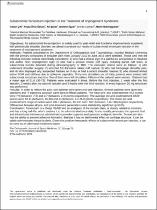| dc.contributor.author | Çift, Hakan | |
| dc.contributor.author | Ünlü Özkan, Feyza | |
| dc.contributor.author | Şeker, Ali | |
| dc.contributor.author | İşyar, Mehmet | |
| dc.contributor.author | Ceyhan, Erman | |
| dc.contributor.author | Mahiroğulları, Mahir | |
| dc.date.accessioned | 2019-05-13T09:07:54Z | |
| dc.date.available | 2019-05-13T09:07:54Z | |
| dc.date.issued | 2014 | |
| dc.identifier.citation | Çift, H., Özkan, F. Ü., Şeker, A., İşyar, M., Ceyhan, E., Mahiroğulları, M. (2014). Subacromial tenoxicam injection in the treatment of impingement syndrome. Orthopaedic Journal of Sports Medicine, 2(11_suppl3). | en_US |
| dc.identifier.issn | 2325-9671 | |
| dc.identifier.uri | https://doi.org/10.1177/2325967114S00199 | |
| dc.identifier.uri | https://hdl.handle.net/11491/1897 | |
| dc.description.abstract | Objectives: As subacromial bursa injection is widely used for pain relief and functional improvements in patients with periarticular shoulder disorder, we aimed to present our results of subacromial tenoxicam injection in the treatment of impingement syndrome. Methods: Patients presented to the Department of Orthopaedics and Traumatology, Istanbul Medipol University with the primary complaints of shoulder pain from January 2012 to June 2013 were selected. Those who met the following inclusion criteria were finally considered: 1) who had a clinical sign of a painful arc and positive in Hawkins test and/or Neer impingement sign; 2) who had a precise rotator cuff injury including partial cuff tears, or subacromial bursitis detected during ultrasonography or MRI. The exclusion criteria were as follows: 1) who underwent shoulder surgery; 2) who had full thickness rotator cuff rupture; 3) who had hemiplegic shoulder pain; and 4) who displayed any suspected fracture on X-ray or had a recent shoulder trauma; 5) who showed limited active ROM and stiffness due to adhesive capsulitis. Thirty one shoulders out of thirty patients were treated with subacromial tenoxicam injection. Ten of them were left shoulders. Fifteen of the patients were women.. Patients had a mean age of 51.6 (30-73). Patients were evaluated 4 times. Before the first injection, 1 week after the first injection, 2 weeks after the second injection and 3 weeks after the third injection. In every injection 20 mg tenoxicam was performed. Results: In order to relieve the pain; two patients were given only one injection, thirteen patients were given two injections and “3 injections protocol” were done to fifteen patients. The mean pre- and posttreatment VAS scores were 7.9 (between, 7-9) and 2.7 (between, 2-4) points respectively. The average pre and posttreatment DASH scores were 59.41 (between, 45-80) and 14 (between, 8.3-25.8) points respectively. The mean pre and posttreatment range of motion were 106.1 (between, 80-130 and 170i7 (between, 140-180) degrees respectively. Differences between all pre- and post-treatment parameters were statistically significant (p<0.05). Conclusion: Tenoxicam is a cheap NSAID and an analgesic of the oxicam class, is closely related to proxicam, and has a long half-life, which enables it to be administrated once daily. It also readily penetrates the synovial fluid and intraarticular intravenous administration provides superior postoperative analgesic benefits. Tenoxicam also has the ability to prevent adhesion formation. Besides it has no detrimental effect on cartilage structure. It can be safely administrated intraarticularly. Given the positive therapeutic effects of subacromial tenoxicam injection, it can be used as an alternative treatment option. © The Author(s) 2014. | en_US |
| dc.language.iso | eng | |
| dc.publisher | SAGE Publications Ltd | en_US |
| dc.relation.isversionof | 10.1177/2325967114S00199 | en_US |
| dc.rights | info:eu-repo/semantics/openAccess | en_US |
| dc.rights | Attribution-NonCommercial-NoDerivs 3.0 Unported (CC BY-NC-ND 3.0) | * |
| dc.rights.uri | https://creativecommons.org/licenses/by-nc-nd/3.0/ | * |
| dc.subject | [Belirlenecek] | en_US |
| dc.title | Subacromial tenoxicam injection in the treatment of impingement syndrome | en_US |
| dc.type | other | en_US |
| dc.relation.journal | Orthopaedic Journal of Sports Medicine | en_US |
| dc.department | Hitit Üniversitesi, Tıp Fakültesi, Cerrahi Tıp Bilimleri Bölümü | en_US |
| dc.identifier.volume | 2 | en_US |
| dc.identifier.issue | 11 | en_US |
| dc.relation.publicationcategory | Diğer | en_US |



















